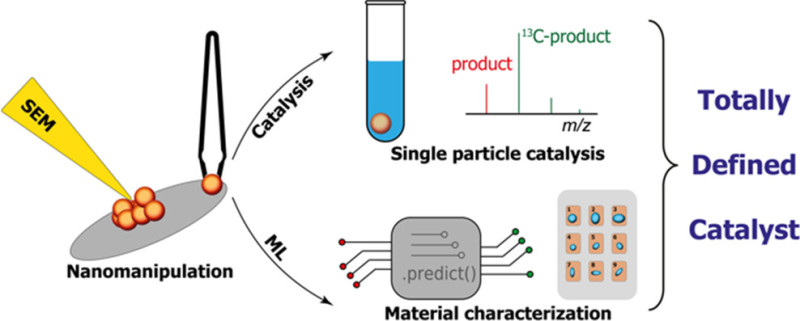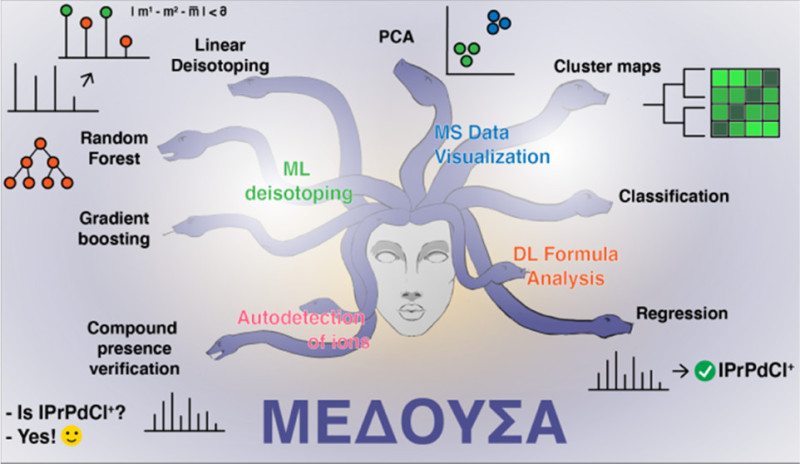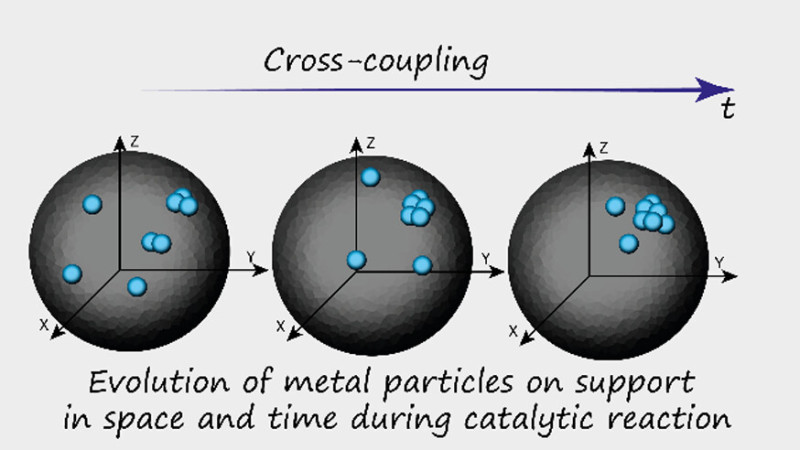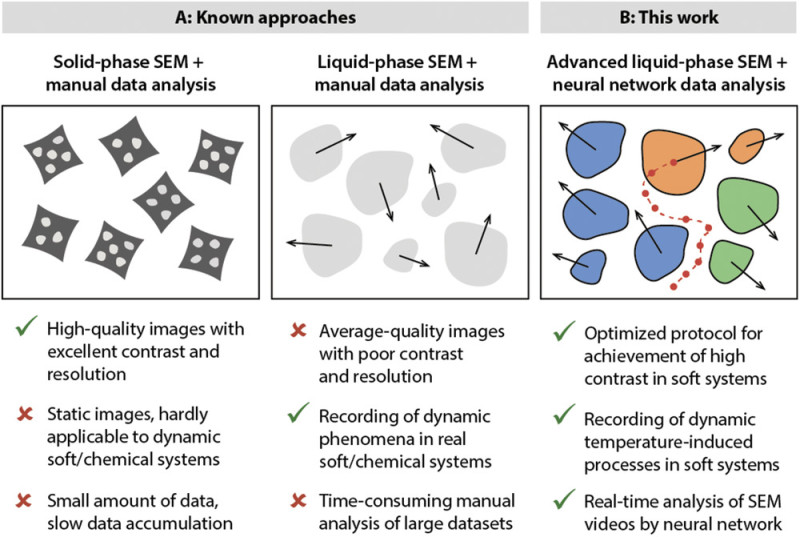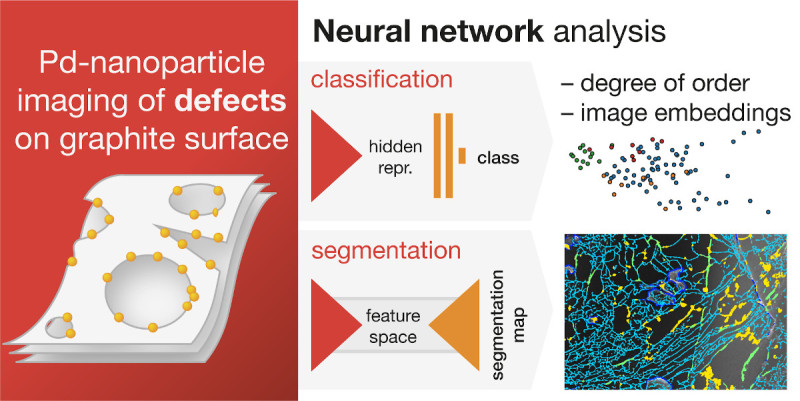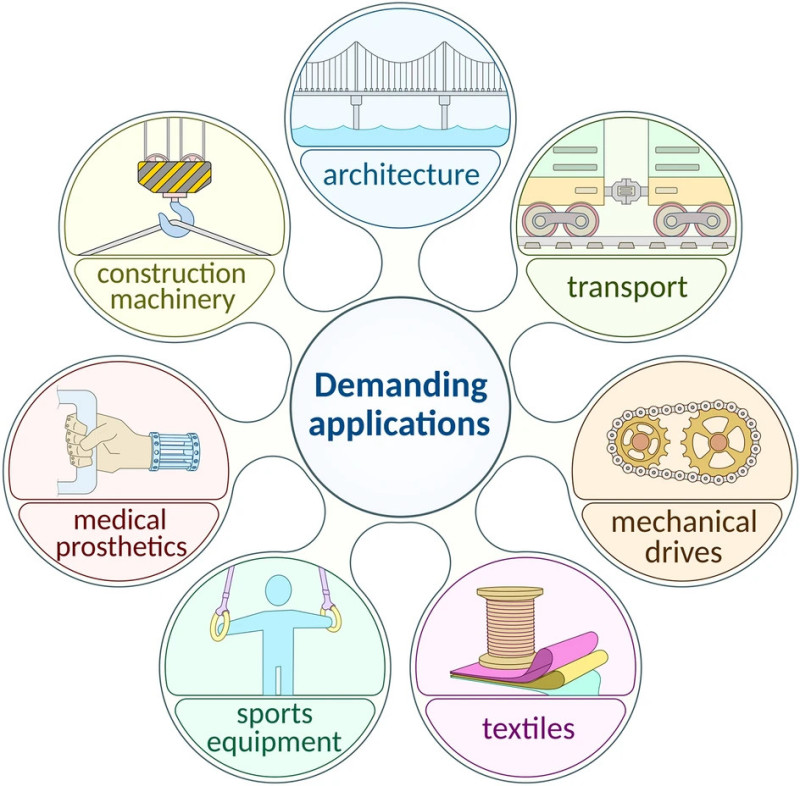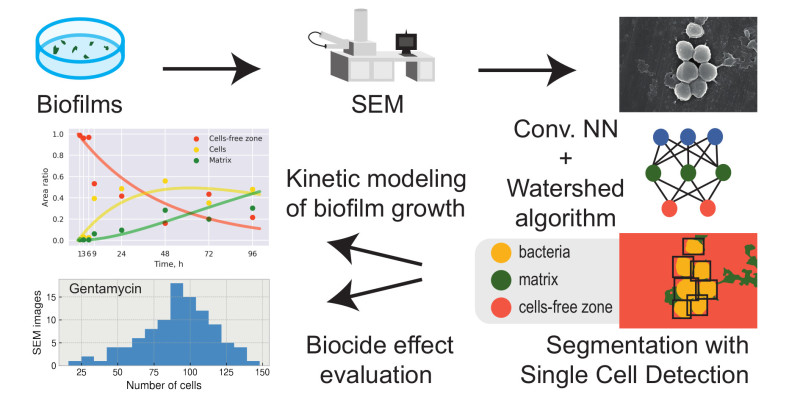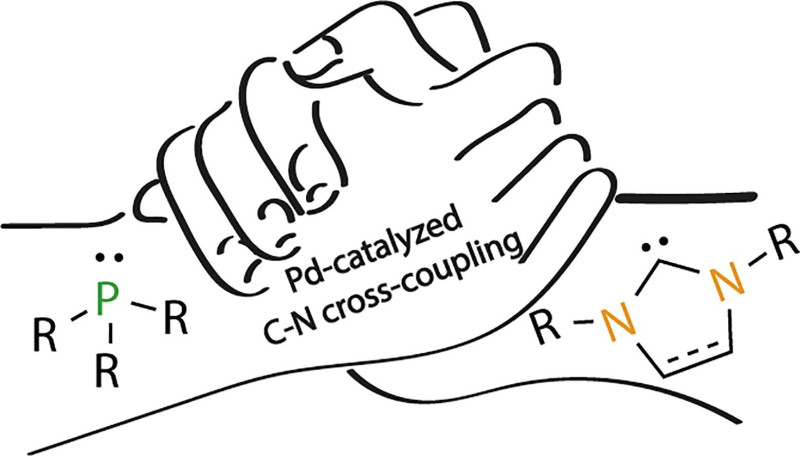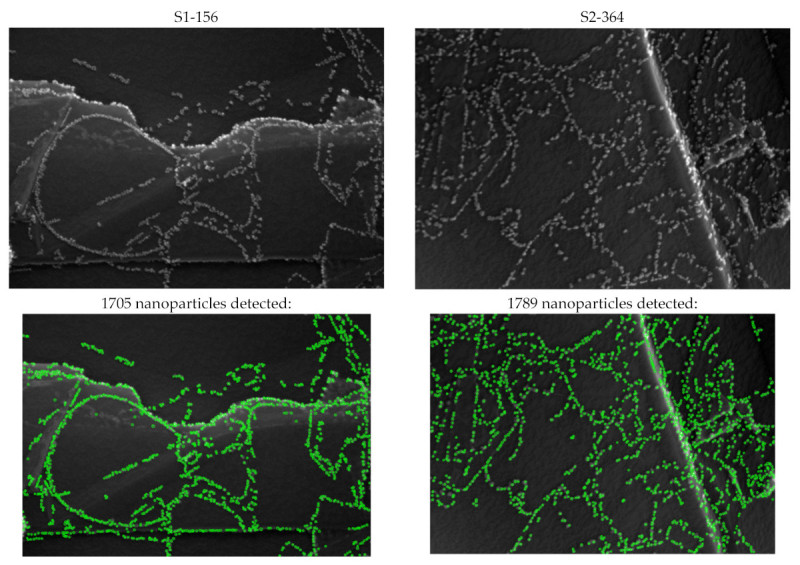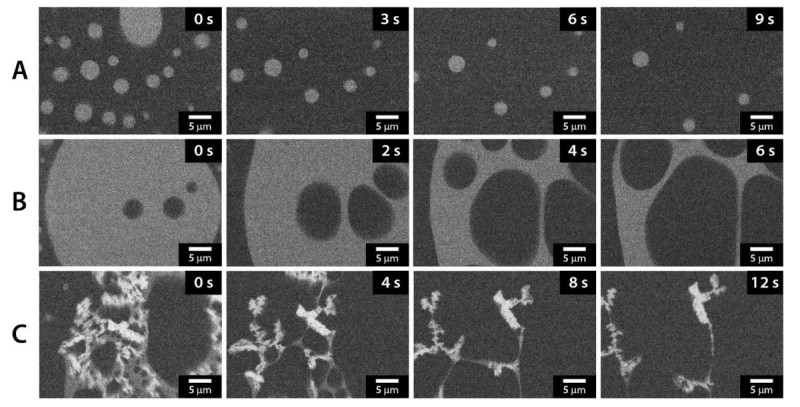AI in Chemitry
The project developed and improved unique competences in the application of artificial intelligence (AI) to solve complex chemistry problems. The project covers a wide range of applications, from analysis of microphase transitions in ionic liquids to nanoparticle recognition, analysis of catalysts at the microscopic level and automatic interpretation of spectra. A key feature is the use of machine learning and deep learning to analyze complex data such as electron microscopic images and mass spectrometric data.
The project actively uses deep learning techniques, including convolutional neural networks and computer vision algorithms, to process and analyze large amounts of data. Methods have been developed to automate the identification of structures, the classification of elements present and the determination of molecular formula. These approaches significantly improve the accuracy and efficiency of analyses.
An important fundamental result is the development of algorithms adapted for chemical problems, creating a modular set of programs and datasets for training and testing AI models, which allows for a better understanding of complex chemical systems. A deeper understanding of the mechanisms of catalyst action and ion interactions in different media has also been achieved.
The project has led to the development of new tools and techniques for the analysis and synthesis of chemical compounds. One example is the use of AI to predict material degradation, which is of great importance in materials science and manufacturing. A crucial part of the project is the development of next-generation high-performance catalysts for fine organic synthesis.
The project demonstrates significant potential for further development and application of AI in chemistry. More research is planned in nanotechnology, catalysis and new materials development. Particular attention will be paid to deepening the understanding of molecular mechanisms and improving data analysis methods for even more accurate and efficient research.
Scientific research and practical projects
The study "Toward Totally Defined Nanocatalysis: Deep Learning Reveals the Extraordinary Activity of Single Pd/C Particles" [DOI: 10.1021/jacs.2c03631] aims to develop an approach to fully defined nanocatalysis using deep learning to explore the activity of single Pd/C particles. The chemical problem being addressed is the development of more efficient and well-defined nanoparticle-based catalytic systems. Deep learning techniques were used to analyze electron micrographs, allowing detailed examination of each catalyst particle and estimation of its activity.
The main scientific achievement is the development of a method that allows us to obtain a detailed view of each nanocatalyst particle and to evaluate their catalytic activity. This research has a significant impact on the understanding and development of nanocatalysis, providing new perspectives for developing highly efficient catalysts and understanding their performance at the microscopic level.
In "Fully Automated Unconstrained Analysis of High-Resolution Mass Spectrometry Data with Machine Learning" [DOI: 10.1021/jacs.2c03631] the application of machine learning to the fully automated analysis of high-resolution mass spectrometry data is developed. The main problem addressed in the paper is related to the analysis of complex mixtures and the identification of individual compounds in them.
The paper used deep learning methods to deisotope and analyze the fine isotopic structure of ions, allowing the automatic determination of molecular formulas of compounds. The main scientific achievement is the development of a method that provides a detailed and unrestricted analysis of the entire mass spectrum, which greatly accelerates the identification and classification of the molecular constituents of complex mixtures.
The research makes an important contribution to the field of mass spectrometry and chemical analysis, offering new possibilities for automated analysis of complex mixtures, which is of great importance for many areas of science and industry.
The project "Time-Resolved Formation and Operation Maps of Pd Catalysts Suggest a Key Role of Single Atom Centres in Cross-Coupling" [DOI: 10.1021/jacs.3c00645] investigated the role of single atom centres in cross-coupling reactions using time-resolved formation and operation maps of palladium-based catalysts. The work investigates the mechanism of catalyst activity at the microscopic level, especially in the context of the dynamic nature of nanoparticles and single atoms.
The study uses electron microscopy and neural network analysis techniques to observe the behavior of single atoms and nanoparticles during the catalytic reaction. The main scientific achievement is to determine the role of single atomic centres in cross-coupling reactions.
The results of the study are important for understanding the mechanisms of nanocatalysis and the development of new catalytic systems. It is shown that detailed analysis at the atomic level can lead to new discoveries in the field of catalysis and synthesis of compounds.
"Neural Network Analysis of Electron Microscopy Video Data Reveals the Temperature-Driven Microphase Dynamics in the Ions/Water System" [DOI: 10.1002/smll.202007726] is devoted to the analysis of microphase dynamics in ionic liquid/water systems using electron microscopy video data and neural networks. The aim of the study is to investigate the behavior of microdomains in mixtures of different ionic liquids with water under the influence of temperature.
The application of computer vision and deep learning methods has made it possible to automate the analysis of video obtained by electron microscopy and to qualitatively assess changes in the morphology of systems consisting of ionic liquids and water upon heating. The main scientific achievement lies in the development of a technique that provides detailed analyses of microphase transitions and microdomain dynamics in real time.
The study significantly affects the understanding of the processes occurring in ionic liquids and reveals new perspectives for their application in various fields of science and technology.
Using the capabilities of neural networks to analyze nanoparticle ordering to identify defects in layered carbon materials was carried out in the paper "Deep neural network analysis of nanoparticle ordering to identify defects in layered carbon materials" [DOI: 10.1039/d0sc05696k]. This project addresses the problem of identifying defects in carbon materials, which is of key importance for various applications including electronics and catalysis.
Machine learning techniques were used to analyze electron microscopy images. This has enabled the automation of the defect identification and classification process. The main scientific achievement is the development of a technique that allows the presence and nature of defects on the surface of carbon materials to be determined with high accuracy and efficiency.
The research makes a significant contribution to materials science and nanotechnology, offering a new approach to analyzing and improving the quality of carbon materials. It opens prospects for the development of more efficient materials with defined properties and for a better understanding of the relationship between material structure and properties.
Thermographic studies combined with machine learning analysis of thermograms were used in the project "Integration of thermal imaging and neural networks for mechanical strength analysis and fracture prediction in 3D-printed plastic parts" [DOI: 10.1038/s41598-022-12503-y] to determine and predict the mechanical strength of 3D-printed plastic parts.
The development of an algorithm that allows to predict with high accuracy the fracture time of plastic parts based on thermographic data is the main scientific achievement of this project. The developed methodology combines traditional mechanical testing with innovative methods of data analysis, which expands the possibilities of quality and safety control of products produced by additive manufacturing methods.
The results of the research are important for the development of 3D printing and materials science technologies, providing new tools for analyzing and improving the mechanical properties of plastic products, which opens new perspectives in mechanical engineering.
The article "Digital biology approach for macroscale studies of biofilm growth and biocide effects with electron microscopy" [DOI: 10.1039/d3dd00048f] is devoted to solving the problem of biofilm analysis using electron microscopy. The paper discusses the use of automated scanning electron microscopy (SEM) combined with an integrated software system using neural networks for deep biofilm analysis. The application of deep learning enabled temporal analysis of macro-scale biofilm images acquired by SEM, enabling microscopic data to be analyzed over an area of biofilm visible to the human eye.
The most important scientific achievement of the paper is the development of a method for the automated analysis of SEM images and the demonstration of its application in studies where large amounts of microscopy data need to be analyzed. This approach has enabled the processing of statistical data on more than 70,000 individual bacterial cells, which is significantly faster than traditional manual analysis.
The scientific significance of this paper is that it offers a new way to quantitatively study biofilms and investigate the effects of antimicrobial compounds on biofilms. This is the basis for further research in microbiology and the development of new antibiotics, especially in the context of the growing antibiotic resistance crisis.
The study "Boosting the generality of catalytic systems by the synergetic ligand effect in Pd-catalyzed C-N cross-coupling" [DOI: 10.1016/j.jcat.2023.115240] addresses an important problem in catalysis chemistry - the development of universal palladium-based catalytic systems that exploit the synergetic ligand effect in Buchwald-Hartwig cross-coupling reactions. The paper focuses on the development of a versatile catalytic system based on a combination of N-heterocyclic carbene (NHC) and phosphine ligands and the evaluation of its efficiency in Buchwald-Hartwig cross-coupling.
The work used machine learning techniques to analyze reaction progress data and identify key factors affecting the efficiency of the catalytic system. The main achievement of the project is the development of a universal catalytic system with high efficiency, which was confirmed by experimental data.
A significant contribution of this research to the field of catalysis is the development of new approaches to the design of efficient catalytic systems using machine learning to optimize their properties. Such methods can serve as a basis for more rational design of new catalytic systems with high efficiency.
Methods of automated recognition of catalytically active palladium nanoparticles in electron microscopy images have been developed in the project "Automated Recognition of Nanoparticles in Electron Microscopy Images of Nanoscale Palladium Catalysts" [DOI: 10.3390/nano12213914]. The paper deals with the task of analyzing scanning electron microscopy images and identifying nanoparticles in these images. Various computer vision and deep machine learning techniques have been applied for automatic recognition and analysis of nanoparticles. The main scientific achievement of the article is to develop and compare different methods for efficient and accurate nanoparticle recognition.
The article highlights the importance of this research in improving the understanding of the structure and properties of nanoscale catalysts, which opens up prospects for further research in the field of nanotechnology and catalysis.
The project "Analyzing ionic liquid systems using real-time electron microscopy and a computational framework combining deep learning and classic computer vision techniques" [DOI: 10.1016/j.molliq.2023.121407] is devoted to analyzing ionic liquid systems using real-time electron microscopy and a computational framework combining deep learning and classical computer vision techniques. The main problem solved in the paper is related to the analysis of dynamic processes in ionic liquids using electron microscopy and the development of efficient algorithms for processing the obtained video data.
The paper uses deep learning and computer vision algorithms to process videos obtained during electron microscopy studies, which allows for detailed analyses of dynamic processes at the micro level. The main scientific achievement of the project is the development of a comprehensive analysis method that allows the study of structural and dynamic properties of ionic liquids with high accuracy.
The study makes a significant contribution to the field of ionic liquids research by offering a new approach to the analysis of dynamic processes at the micro level, which can be used for further research in this area.
Analyses of the degree of nanomaterial ordering effects and location of nanoparticles using electron microscopy data were performed in "Electron microscopy dataset for the recognition of nanoscale ordering effects and location of nanoparticles" [DOI: 10.1038/s41597-020-0439-1]. This project addresses the important problem of recognition and analysis of nanostructured materials, especially in the context of palladium-based catalysts.
The main scientific achievement is the creation and analysis of an extensive dataset that includes images of ordered and disordered nanomaterials. This provides a better understanding of the structure and properties of such materials. The study is of great importance for the development of methods for analyzing nanomaterials and can be used for further research in nanotechnology and catalysis.
References
1. Eremin D. B., Galushko A. S., Boiko D. A., Pentsak E. O., Chistyakov I. V., Ananikov V. P., "Toward Totally Defined Nanocatalysis: Deep Learning Reveals the Extraordinary Activity of Single Pd/C Particles", J. Am. Chem. Soc., 2022, 144, 13, 6071-6079. https://doi.org/10.1021/jacs.2c01283
2. Boiko D. A., Kozlov K. S., Burykina J. V., Ilyushenkova V. V., Ananikov V. P., "Fully Automated Unconstrained Analysis of High-Resolution Mass Spectrometry Data with Machine Learning", J. Am. Chem. Soc., 2022, 144, 32, 14590-14606. https://doi.org/10.1021/jacs.2c03631
3. Galushko A. S., Boiko D. A., Pentsak E. O., Eremin D. B., Ananikov V. P., "Time-Resolved Formation and Operation Maps of Pd Catalysts Suggest a Key Role of Single Atom Centers in Cross-Coupling", J. Am. Chem. Soc., 2023, 145, 16, 9092-9103. https://doi.org/10.1021/jacs.3c00645
4. Kashin A. S., Boiko D. A., Ananikov V. P., "Neural Network Analysis of Electron Microscopy Video Data Reveals the Temperature-Driven Microphase Dynamics in the Ions/Water System", Small, 2021, 17, 24, 2007726. https://doi.org/10.1002/smll.202007726
5. Boiko D. A., Pentsak E. O., Cherepanova V. A., Ananikov V. P., "Electron microscopy dataset for the recognition of nanoscale ordering effects and location of nanoparticles", Scientific Data, 2020, 7, 101. https://doi.org/10.1038/s41597-020-0439-1
6. Boiko D. A., Pentsak E. O., Cherepanova V. A., Gordeev E. G., Ananikov V. P., "Deep neural network analysis of nanoparticle ordering to identify defects in layered carbon materials", Chem. Sci., 2021, 12, 7428-7441. https://doi.org/10.1039/d0sc05696k
7. Grebennikov N. O., Boiko D. A., Prima D. O., Madiyeva M., Minyaev M. E., Ananikov V. P., "Boosting the generality of catalytic systems by the synergetic ligand effect in Pd-catalyzed C-N cross-coupling", J. Catal., 2024, 429, 115240. https://doi.org/10.1016/j.jcat.2023.115240
8. Boiko D. A., Kashin A. S., Sorokin V. R., Agaev Y. V., Zaytsev R. G., Ananikov V. P., "Analyzing ionic liquid systems using real-time electron microscopy and a computational framework combining deep learning and classic computer vision techniques", J. Mol. Liq., 2023, 376, 121407. https://doi.org/10.1016/j.molliq.2023.121407
9. Boiko D. A., Sulimova V. V., Kurbakov M. Y., Kopylov A. V., Seredin O. S., Cherepanova V. A., Pentsak E. O., Ananikov V. P., "Automated Recognition of Nanoparticles in Electron Microscopy Images of Nanoscale Palladium Catalysts", Nanomaterials, 2022, 12, 3914. https://doi.org/10.3390/nano12213914
10. Boiko D. A., Korabelnikova V. A., Gordeev E. G., Ananikov V. P., "Integration of thermal imaging and neural networks for mechanical strength analysis and fracture prediction in 3D-printed plastic parts", Sci. Rep., 2022, 12, 8944. https://doi.org/10.1038/s41598-022-12503-y
11. Kozlov K. S., Boiko D. A., Detusheva E. V., Detushev K. V., Pentsak E. O., Vereshchagin A. N., Ananikov V. P., "Digital biology approach for macroscale studies of biofilm growth and biocide effects with electron microscopy", Digital Discovery, 2023, 2, 1522-1539. https://doi.org/10.1039/d3dd00048f
12. Kurbakov M. Yu., Sulimova V.V., Kopylov A.V., Seredin O.S., Boiko D.A., Galushko A.S., Cherepanova V.A., Ananikov V.P., "Determining the orderliness of carbon materials with nanoparticle imaging and explainable machine learning", Nanoscale, 2024, 16, 13663-13676. https://doi.org/10.1039/D4NR00952E



